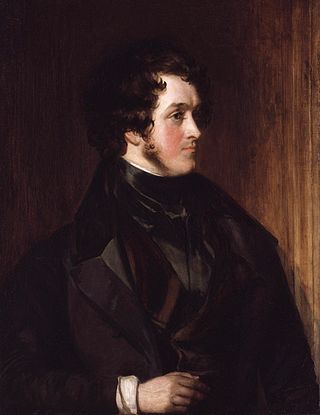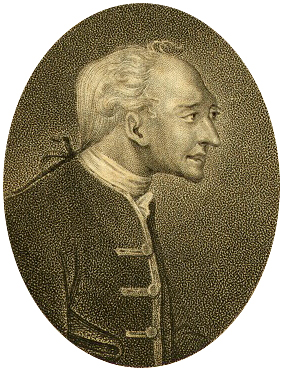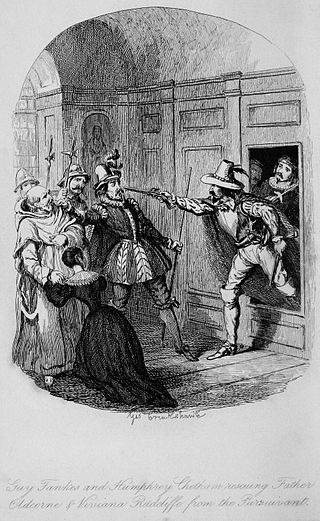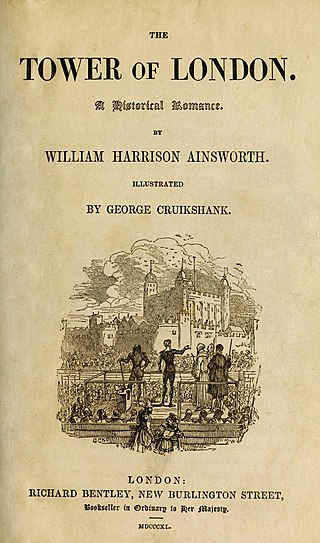This article contains information about the literary events and publications of 1834.

William Harrison Ainsworth was an English historical novelist born at King Street in Manchester. He trained as a lawyer, but the legal profession held no attraction for him. While completing his legal studies in London he met the publisher John Ebers, at that time manager of the King's Theatre, Haymarket. Ebers introduced Ainsworth to literary and dramatic circles, and to his daughter, who became Ainsworth's wife.

A miser is a person who is reluctant to spend money, sometimes to the point of forgoing even basic comforts and some necessities, in order to hoard money or other possessions. Although the word is sometimes used loosely to characterise anyone who is mean with their money, if such behaviour is not accompanied by taking delight in what is saved, it is not properly miserly.

John Elwes MP was a member of parliament (MP) in Great Britain for Berkshire (1772–1784) and an eccentric miser, suggested to be an inspiration for the character of Ebenezer Scrooge in Charles Dickens' A Christmas Carol. Dickens made reference to Elwes in Bleak House (1853) – along with another notable 18th century miser, Daniel Dancer – and some years later in his last completed novel, Our Mutual Friend. Elwes was also believed to inspire William Harrison Ainsworth to create the character of John Scarfe in his novel The Miser's Daughter.

This is a list of works by the English historical novelist William Harrison Ainsworth (1805–1882).
Artist and the Author is a pamphlet written by George Cruikshank in 1872. During the late 1860s, Cruikshank claimed to be the author of works attributed to other writers, including Charles Dickens and William Harrison Ainsworth. After John Forster contradicted Cruikshank's claims to having "originated" Oliver Twist, Cruikshank began a dispute in The Times as being the creator of novels attributed to Ainsworth. After the newspaper stopped carrying the dispute, Cruikshank produced all of his claims in Artist and the Author, where he disputed his relationship to 8 of Ainsworth's novels.

Windsor Castle is a novel by William Harrison Ainsworth serially published in 1842. It is a historical romance with gothic elements that depicts Henry VIII's pursuit of Anne Boleyn. Intertwined with the story are the actions of Herne the Hunter, a legendary ghost that haunts Windsor woods.

Jack Sheppard is a novel by William Harrison Ainsworth serially published in Bentley's Miscellany from 1839 to 1840, with illustrations by George Cruikshank. It is a historical romance and a Newgate novel based on the real life of the 18th-century criminal Jack Sheppard.

The novel Guy Fawkes first appeared as a serial in Bentley's Miscellany, between January and November 1840. It was subsequently published as a three-volume set in July 1841, with illustrations by George Cruikshank. The first of William Harrison Ainsworth's seven "Lancashire novels", the story is based on the Gunpowder Plot of 1605, an unsuccessful attempt to blow up the Houses of Parliament. Ainsworth relied heavily on historical documents describing the trial and execution of the conspirators, of whom Fawkes was one, but he also embellished the known facts. He invented the character of Viviana Radcliffe, daughter of the prominent Radcliffe family of Ordsall Hall – who becomes Fawkes's wife – and introduced gothic and supernatural elements into the story, such as the ability of the alchemist, John Dee, to raise the spirits of the dead.

The Tower of London is a novel by William Harrison Ainsworth serially published in 1840. It is a historical romance that describes the history of Lady Jane Grey from her short-lived time as Queen of England to her execution.
St. James's is a novel by William Harrison Ainsworth serially published in 1844. It describes the events surrounding the end of Queen Anne's reign and the dispute between the Duke and Duchess of Marlborough with two Tories for influence over the queen.

Old St. Paul's, also titled Old Saint Paul's: A Tale of the Plague and the Fire, is a novel by William Harrison Ainsworth serially published in 1841. It is a historical romance that describes the events of the Great Plague of London and the Great Fire of London. It was the basis for the 1914 silent film Old St. Paul's.

Rookwood is a novel by William Harrison Ainsworth published in 1834. It is a historical and gothic romance that describes a dispute over the legitimate claim for the inheritance of Rookwood Place and the Rookwood family name.
William Jennens (1701–1798), also known as William the Miser, William the Rich, and The Miser of Acton, was a reclusive financier who lived at Acton Place in the village of Acton, Suffolk, England. He was described as the "richest commoner in England" when he died unmarried and intestate with a fortune estimated at £2 million, which became the subject of legal wrangles in the Court of Chancery for well over a century despite the fact that all Jennen's real and personal estate had been distributed to his closest living relatives in a relatively short time after his death. The Jennens case is often cited as having provided inspiration for Jarndyce v Jarndyce in Charles Dickens' serialised novel Bleak House.

The Constable of the Tower is an 1861 historical novel by the British writher William Harrison Ainsworth. Originally serialised in Bentley's Miscellany it was then published in three volumes. It is set in Tudor England following the death of Henry VIII and focuses in particular in the rule of the Lord Protector Duke of Somerset and his subsequent downfall, imprisonment in the Tower of London and execution in 1552. The illustrations were provided by John Gilbert. The sales of the novel were considered disappointing by his publishers Chapman and Hall.

The Spanish Match is an 1865 three-volume historical novel by the British writer William Harrison Ainsworth. It was originally serialised in Bentley's Miscellany under the alternative title House of the Seven Chimneys, a reference to the English Embassy in Spain. It was then published in London by Chapman and Hall. It is based on the historic Spanish match, a proposed marriage between the English and Spanish royal families in the 1620s.

Boscobel is an 1872 historical novel by the British writer William Harrison Ainsworth. It first appeared as a serial in The New Monthly Magazine before being published in three volumes by the London publishing house Tinsley Brothers. It marked a return to the historical subjects he was best known for, after producing three novels with contemporary settings such as Old Court (1867) and Myddleton Pomfret (1868). It takes place in the weeks before and following the Battle of Worcester in 1651, in which Charles II avoided capture after his defeat by his republican enemies under Oliver Cromwell. His escape included hiding in the royal oak at Boscobel House in Shropshire, from which the novel takes its title. It also formed the first of a trio of "Jacobite" novels sympathetic to the Stuart Dynasty, followed by The Manchester Rebels (1873) and Preston Fight (1875).

Preston Fight is an 1875 historical novel by the British author William Harrison Ainsworth, released in three volumes by the London publishing house Tinsley Brothers. Like his earlier novel The Manchester Rebels, it was set against the backdrop of a Jacobite uprising in this case the 1715 Jacobite rebellion. The main focus of the story is the rising in Northumberland and northern England rather than that in Scotland, although Scottish commander William Mackintosh plays a major role in the plot. It features an apocryphal visit by James Francis Edward Stuart to Northumberland in the period before the rising.

James the Second is an 1848 historical novel by the British writer William Harrison Ainsworth. It was published in three volumes by Henry Colburn. It is set during the reign of James II and the Glorious Revolution of 1688. It was published the same year as a series of European revolutions broke out.

The Spendthrift is an 1857 historical novel by the British author William Harrison Ainsworth. It was published in a single volume by London publisher Routledge. It was initially serialised in Bentley's Miscellany from January 1855. Illustrations were provided by Hablot Knight Browne. It is set in the eighteenth century and follows the misadventures of a young man who inherits a fortune.















